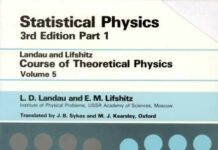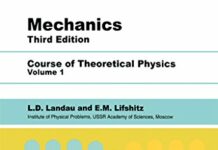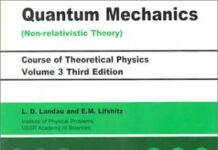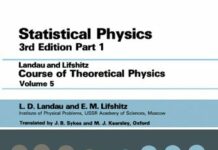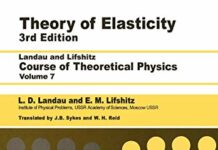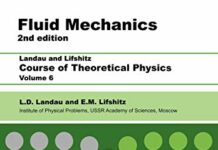
Ebook Info
- Published: 1980
- Number of pages: 444 pages
- Format: PDF
- File Size: 40.72 MB
- Authors: L D Landau
Description
The fourth edition contains seven new sections with chapters on General Relativity, Gravitational Waves and Relativistic Cosmology. The text has been thoroughly revised and additional problems inserted.The Complete course of Theoretical Physics by Landau and Lifshitz, recognized as two of the world’s outstanding physicists, is published in full by Butterworth-Heinemann. It comprises nine volumes, covering all branches of the subject; translations from the Russian are by leading scientists.
User’s Reviews
Editorial Reviews: Review ‘The clarity of style, the conciseness of treatment and the originality and variety of illustrative problems make this a book which can be highly recommended.’ Proceedings of the Physical Society
Reviews from Amazon users which were colected at the time this book was published on the website:
⭐Landau was a master: Concise, insightful, and capable of prodding the student’s intellect to solve problems for oneself.As this text elucidates, Electrodynamics cannot be properly understood without the uber-principle of Relativity as foundation; and that is just the beginning.I am still fascinated and a little exhilarated every time I am reminded of the Gauge Invariance associated with the Electrodynamic field. Landau broaches this subject near the very beginning of the text (Paragraph 18) in an elegant way. Because the definitions of the Magnetic field (B) and Electric field (E) contain only the DERIVATIVES of the corresponding potentials rather than the potentials themselves (A, and phi, respectively), it’s easily proven that adding constants to the potentials will not affect the field intensities (remember the derivative of a constant = zero!).Here’s the MathExample: E Field only:E = -1/c (dA/dt) – grad(phi)But if we change A and phi by adding constants to them, i.e.:A’ = A + grad(f)phi’ = phi – 1/c(df/dt)Thus, the new field E’ = -1/c (dA’/dt) – grad (phi’)or, expanding:E’ = -1/c (dA/dt) – 1/c (d/dt grad(f)) – grad (phi) + 1/c grad (df/dt)The second and fourth terms on the right cancel, so E’ = -1/c (dA/dt) – grad (phi) = E.The field intensity is unchanged despite changing the potentials.Same result obtains when considering the Magnetic field B = curl AAnother bombshell is that no matter how one is moving, the total Electrodynamic field does not change. Relative motion will change the measured intensity of the magnetic component B, or perhaps the electric component E depending on how one is moving, but there will always be a resultant compensating change in the one component when there is a change in the other, such that the full field remains unchanged. This represents the essential truth that the Electrodynamic field is a TENSOR, whose physical character is not affected by relative motion; it is invariant in any reference frame.Consider the profound ramifications bound in that concept: A light wave whose existence begins on the surface of some star, potentially traverses 6 or 7 reference frames before it is absorbed in some planets’ atmosphere, or perhaps within a leaf. If a measurement is performed on that light wave within any of those reference frames, that measurement will betray the character of said reference frame; so in a sense, perhaps the electromagnetic (electrodynamic!) wave serves as a UNIVERSAL FRAME OF REFERENCE: TRULY INERTIAL.Mirror image of that statement is that if one could rather travel with the wave, as Einstein envisioned, one would “see” the rest of the universe without time, and thus without the effect of MOTION as one traversed these many different reference frames (galaxy, solar system, planetary orbit, rotating planet, etc).An analogous result obtains when considering even mechanical motion and time: Motion through space (x,y,z, or r, theta, phi, or x1, x2, x3) sacrifices motion through time (ct, or x4) such that the interval through space-time (x1, x2, x3, x4) is always unchanged; invariant. This is how the measurement of time becomes relative. Motion through time is contracted to compensate for the motion through space, keeping the interval invariant.Both the Electrodynamic Field and the Gravitational Field are Gauge Fields.Another principle that bent my brain Landau covers in paragraph 95: The equations of the gravitational field also contain the equations for the matter which produces said field.From which the central conclusions may be deduced.Matter is FieldField and matter do not really fill space, like we all intuitively think. Rather, empty space has no objective measurable reality.As Einstein put it: “There is no space empty of field”Thus: Field….. is….. Space
⭐A timeless classic.
⭐The author builds up a whole theory from almost nothing but common sense. You soon find yourself on page 150 as if you are reading Jane Austin. Landau’s exposition is detailed but not boring, he gets to the fundamental facts right away. They define the electromagnetic field as derivatives of a potential. Great insight for people with background in mathematics. I always heard ‘The electromagnetic field is the curvature of the connection.’ but I didn’t quite understand what they meant by that. Now I know.
⭐Landau’s approach to Classical Field Theory demonstrates his ability to be clear, concise, and elegant without drowning out the physics with math. I will say, however, that Landau requires a certain maturity to appreciate his style (same goes for Rudin’s books of analysis). I would recommend this title to those with a working knowledge of classical E & M, vector/tensor analysis, and of special relativity. It is also wise to work through the author’s Theoretical Mechanics to get a taste of their style. I believe, contrary to many, that this book is appropriate for self study if one is willing to do the work (not only the exercises but following along pencil in hand). I suggest reading a passage and then covering it up and then trying to do the derivations by hand. My only complaint is the quality of print, which has is not the fault of the authors. It is especially annoying at first.
⭐I have read the old version in French which was very concise and the new one is even more concise.Landau & Lipchitz do not need recommendation as I think they are the best books I know of. I recommend the book of Field Theory to those who already are knowledgeable and who would like to add a high level overview on the field theory (including Relativity).This overview goes in parallel with a deep insight on the various aspects of the theory.(I also very strongly recommend Vol1 : Classical Mechanics of the same authors)
⭐One of the greatest physics texts ever written. Landau immediately jumps into the water with clear descriptions of Einstein’s principle of relativity and proceeds from there into momentum, plane waves, diffraction and the rest of modern theory. You cannot find a clearer, easier to read or more principle-driven elaboration of modern physics and fields.
⭐It’s so simple to read and just to the point. I honestly had to use the Jackson book, which was not that great, but made a great grade because of the Landau-Lifshitz classic. Then there was the advanced MIT EM book which made so much more sense, but it was all math. Those 3 books alone will give you a pretty adequate understanding of EM, enough to make over 95 out of 100 on every assignment. The Landau, MIT book together are well pretty cool themselves.
⭐I just got this book in and haven’t had a chance to read past chapter 1, so if you’re looking for a book review see the below comments. However I just wanted to state that the print quality of the new addition is fantastic and is like that of more modern texts. Perhaps the quality of the older texts is sub par, but rest assured that if you buy the newer addition you will get your money’s worth.
⭐Warning to young physics students: if you start learning physics with the Landau books, you won’t really know what physics is about. Also, you run the risk of depression, because you are reading raving reviews on amazon, and then don’t understand what the author is saying. I am serious. I have delved into two of Landau’s books, this one and “Classical Mechanics”. An ordinary physics book goes from experiments (special cases) to some theory (the generalization). During my study, i read Sommerfeld’s books; he did it this way, and i loved it. Landau is doing the opposite: he gives you the most general principle (usually the principle of least action), and then makes a still rather general analysis of what follows from it. This is a kind of second level approach: you must have passed through the first (Sommerfeld) level to appreciate it. Otherwise you don’t understand what’s going on.I am not saying Landau’s approach is wrong. I deducted 2 (or 1 1/2) stars for other reasons. The first one is prosaic: this fourth edition still has rather many printing mistakes, mainly in the formulas. Given Landau’s stellar renown in physics, this is a bit disappointing.The second reason is the sometimes (to me) unclear or careless style of writing. I will try to make my point by nitpicking in page 243, where general relativity starts.”…in an inertial reference system, the free motion of all bodies is uniform and rectilinear.” -> That’s fine in special relativistic mechanics; but in general relativistic mechanics, space-time is curved; how do you define an inertial system in this case? (Only many pages later does Landau explain how to physically make a general reference system – it’s far from trivial.)”Thus the properties of motion in a non-inertial system are the same as those in an inertial system in the presence of a gravitational field.” -> Properties of motion? Sounds vague. How about “equation of motion”? Or simply “motion”? And then, may be “a certain gravitational field” (not any gravitational field)?”Thus a uniformly accelerated system of reference is equivalent to a constant, uniform external field.” -> This should probably be “Thus a uniformly accelerated, FIELD-FREE system of reference is equivalent to AN INERTIAL SYSTEM OF REFERENCE with a constant, uniform field.” (Why “external”?)”In the same way, nonuniformity accelerated linear motion of the reference system is clearly equivalent to a uniform but gravitational field” -> This should probably be “In the same way, nonuniformLY accelerated linear motion of the reference system is clearly equivalent to a uniform but TIME-DEPENDENT gravitational field.””…their [actual gravitational fields’] behaviour at infinity.” -> As i said before, in GRM space-time is curved, and if there is enough mass, space is closed (= has a finite volume), so better avoid talking about infinity.
⭐Had to buy this book to help me at work – it’s very advanced and good referencing material, and the delivery was quick as well – can’t complain about anything
⭐It is a fundamental physics book written by a genius physicist, that all physics students should have.I recommend it.
⭐Es una impresión muy pobre y demasiado mala, el contenido del libro es de lo mejor en física teórica.Varias páginas están tan mal impresas que es imposible ver el texto y fórmulas.Es mejor gastar un poco más con otra impresión a pagar tirar a la basura el dinero con esta editorial.En cuestión al contenido del libro, es muy buena, los L. D. Landau son de los mejores libros para física, un poco avanzado pero muy buen contenido.
⭐
⭐Excelente curso de física teórica que presenta los conceptos de teoría de campos a un nivel de posgrado, recomendable también para investigadores que deseen profundizar los aspectos descritos en este curso.
⭐
Keywords
Free Download The Classical Theory of Fields: Volume 2 4th Edition in PDF format
The Classical Theory of Fields: Volume 2 4th Edition PDF Free Download
Download The Classical Theory of Fields: Volume 2 4th Edition 1980 PDF Free
The Classical Theory of Fields: Volume 2 4th Edition 1980 PDF Free Download
Download The Classical Theory of Fields: Volume 2 4th Edition PDF
Free Download Ebook The Classical Theory of Fields: Volume 2 4th Edition
